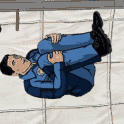|
grover posted:That's my thoughts as well. What's the standard height of a runway light? average height of a taxiway/runway edge light is about 2' feet, the runway distance sign in the other picture is about 4x4 feet. In case you want a source: http://www.faa.gov/documentLibrary/media/Advisory_Circular/150_5345_44j.pdf
|
|
|
|

|
| # ? May 22, 2024 18:49 |
|
Tsuru posted:Convince me of what, exactly? That it does not matter what size or colour it is? The thing with UAV designs is that they scale really really well to suit a particular task, because there is no fleshy bit in the front of a given size. This moves your design starting point to the designed range/fuel capacity and the amount of payload that it has to carry. Given that this particular example was flown from Afghanistan to Iran and not from a base in the USA like a Global Hawk or a Polecat actually convinces me that the size of this thing looks pretty spot-on. Its comparative size to the taxiway lights in the other pictures also confirms that the size matches. Except you're wrong. Color does matter. Evidence!=proof. A stealth aircraft is coated with special paint. IT DOES NOT COME IN TAN. Tan would be a poor choice for aerial camouflage as well. There is no reason the USAF would go that route. This thing is way too small to have a decent sensor suite or payload. This size would limit it to roughly the capability of a Predator/Reaper, which would be pretty ridiculous to spend the kind of time and money it would take to drop the RCS. There are smaller RCS systems that have similar sensor capabilities already in existence, this thing would be redundant. Not only that, the mockup Iran displayed isn't large enough for the engine. This alone should prove the point. Wings don't break off along a seam like that. A wing also couldn't be held up by loving BONDO.
|
|
|
|
Butt Reactor posted:average height of a taxiway/runway edge light is about 2' feet, the runway distance sign in the other picture is about 4x4 feet. In case you want a source: http://www.faa.gov/documentLibrary/media/Advisory_Circular/150_5345_44j.pdf
|
|
|
|
Godholio posted:Except you're wrong.
|
|
|
|
Godholio posted:Except you're wrong. I'm pretty sure the bondo job on the wing was done by Iran in order to present it to the public as "whole and intact!" e: The CIA has pretty much admitted they have one, I don't see why you're in a higher state of denial than the CIA, I didn't even think that was possible Mr.Peabody fucked around with this message at 16:26 on Dec 9, 2011 |
|
|
|
Here's a video with a little more to look at than the previous stills http://youtu.be/vorWHmk38yE
|
|
|
|
Mr.Peabody posted:I'm pretty sure the bondo job on the wing was done by Iran in order to present it to the public as "whole and intact!" I'm sure they've recovered some wreckage. Those photos are not of that wreckage however.
|
|
|
|
Tsuru posted:I don't think assumptions are proof either, but let's just wait and see. I'm sure in good time we'll know. I'm not really making a lot of assumptions. That thing is too small to hold the engine that powers it. I guess the paint thing is kind of an assumption, but it's based on my experience in the Air Force. I'm pretty confident about it. I'm familiar with the sensor suites used on USAF UAVs. That thing isn't big enough to carry anything better than what the cheap/disposable UAV already carries.
|
|
|
|
Godholio posted:I'm not really making a lot of assumptions. That thing is too small to hold the engine that powers it. Previous pictures show that its a correct color job, but of course, this could be an Iranian Maaco color match. The engine listed by Aviation Week was a guess before anyone had any hard measurements. It could just as easily be a PW600 series or something equally tiny. I highly doubt you would take the time to develop a black project UAV operated by the CIA without having it operate a sensor suite worth flying, personally. Especially if the reports that the president was offered three strike options to destroy the drone are true. You wouldn't even consider that if its a predator-pack. CIA has confirmed a lost drone, and hasn't done anything to say that the pictures are not legit. Seems pretty likely that they lost an RQ-170, that it probably came down hard, and that Iran has pieced together what they can while filling in the rest.
|
|
|
|
If we can check the drone color using Google, so can Iran.
|
|
|
|
Godholio posted:I'm not really making a lot of assumptions. That thing is too small to hold the engine that powers it.
|
|
|
|
Tsuru posted:As much as I hate to point out the obvious, and as incomprehensible as this concept may be to a proud American such as yourself: bigger is not necessarily better. Really dude? He's in a good position to be making comments.
|
|
|
|
Tsuru posted:As much as I hate to point out the obvious, and as incomprehensible as this concept may be to a proud American such as yourself: bigger is not necessarily better. Is this a burn or something, it doesn't even... make sense? He's saying the engine AW listed in it wouldnt fit in the Iranian display, which is true?
|
|
|
|
Tremblay posted:Really dude? He's in a good position to be making comments. It was an attempt at humour, but let's just forget about it before more egos are harmed. Tsuru fucked around with this message at 19:59 on Dec 9, 2011 |
|
|
|
I can believe that maybe it was damaged enough that they just put a coat of paint on it and bondo'd it enough to look "presentable." My issue is the size: IF it's really powered by the TF34 like everyone says, I have no idea where one of those would fit in there:  http://en.wikipedia.org/wiki/General_Electric_TF34 Then again, it's Previa_fun fucked around with this message at 17:57 on Dec 11, 2011 |
|
|
|
Godholio posted:I'm not really making a lot of assumptions. That thing is too small to hold the engine that powers it. It does seem small, but I'm not convinced it's too small to hold the engine. I think it looks smaller than it really is. To be clear, I am far from sold that's the genuine article, but I don't think it's as painfully obvious as some say it is that it isn't.
|
|
|
|
Crosspost from GBS: http://www.space.com/13879-spacex-dragon-space-station-launch-date-announced.html quote:NASA announced the launch date for the first test flight of a commercial spacecraft to the International Space Station today (Dec. 9). The mission, which will test a vehicle intended to carry cargo, and eventually crew, to orbit, represents an important step for the burgeoning private space industry, experts say. This is very good news.
|
|
|
|
slidebite posted:Crosspost from GBS: Yes, especially after having to go through another JWST hearing this week. Glad they are combining the mission, wonder how dicey that will be for the ISS crew. No doubt game faces all around when that goes on. I don't think people realize how dangerous it is up there, and hopefully we won't be reminded anytime soon.
|
|
|
|
AW has got a big article up. The consensus is that Goholio was right about the sensor package, nothing really that fancy so nobody is really that worried about that aspect. Although if the Chinese or Russians get a hold of the whole airframe, they might be a little more concerned. http://www.aviationweek.com/aw/generic/story_generic.jsp?channel=awst&id=news/awst/2011/12/12/AW_12_12_2011_p19-402987.xml
|
|
|
|
Well drat. I'll only take partial credit on that. I figured if they were going to go to the trouble building a system like this they'd put something bigger than FMV/Pred pods on it. Still looks crazy loving small for a TF34-powered aircraft, though.
|
|
|
|
Godholio posted:Well drat. I'll only take partial credit on that. I figured if they were going to go to the trouble building a system like this they'd put something bigger than FMV/Pred pods on it. According to Wiki it could also be powered by the Garrett TFE731, but I don't know if the citation they have on the TF34 is for both or what. Those engines are crazy different in size though, the 731 being about half the length.
|
|
|
|
Styles Bitchley posted:Yes, especially after having to go through another JWST hearing this week. Glad they are combining the mission, wonder how dicey that will be for the ISS crew. No doubt game faces all around when that goes on. I don't think people realize how dangerous it is up there, and hopefully we won't be reminded anytime soon. Sounds like they're going to get it into station keeping for a while to check everything out before they let it get too close. But yeah, the first time will be a real nail biter for sure.
|
|
|
|
Well, I just read one of the most heartbreaking things I've read in a while, the cockpit transcript of AF447. Seems like a bit of icing, a whole shitload of confusion and forgetting how to fly a plane and just coming to grips with it seconds after it was too late was the root of it. quote:
slidebite fucked around with this message at 03:49 on Dec 10, 2011 |
|
|
|
slidebite posted:Well, I just read one of the most heartbreaking things I've read in a while, the cockpit transcript of AF447. I can't figure out how Bonin was able to tie his shoes without a full-authority digital Shoelace Control System.
|
|
|
|
That is utterly terrifying. It sounds like Bonin's mind shut down and he didn't think enough to realize he needs to push forward. This should have been obvious once he regained his airspeed readings. The human brain does strange things under intense stress, though. Sadly, many people had to die because Bonin froze up.
|
|
|
|
What is really amazing, is that all three pilots completely tuned out the stall warning. During the entire sequence, the airplane was loving telling them what was happening, and they completely ignored it. Also, the lack of feedback between the two sticks seems (now, in retrospect) to be a pretty dumb thing. If the left seater had been unable to push his stick forward without a lot of effort, he might have clued into the fact that Bonin was literally stalling them into the ocean the entire time.
|
|
|
|
Ridge_Runner_5 posted:That is utterly terrifying. It sounds like Bonin's mind shut down and he didn't think enough to realize he needs to push forward. I wonder how his family feels about that transcript being released. Also, I am surprised by the lack of haptic feedback offered up by Airbus...might have revealed to the other pilot that Bodin had brain-locked and hauled back on the control stick for the duration of the event. That's the worst part, I think..."I don't know why this is happening, I've had the stick pulled back all this time!" e: ^^ beaten, and also yes, surprised by ignoring the stall alarm screaming. Some serious CRM failure up there on the flight deck, and interesting psychological effects at play movax fucked around with this message at 04:05 on Dec 10, 2011 |
|
|
|
Ridge_Runner_5 posted:That is utterly terrifying. It sounds like Bonin's mind shut down and he didn't think enough to realize he needs to push forward. There's more to it than that. First, you should never ignore a stall warning. Second, they shouldn't have such rock-solid faith that the normal-mode FCS won't let the pilot stall the airplane that it honestly doesn't even occur to them that the warning's a legitimate alarm. Third, the notion of a stall warning if the FCS is in normal-mode and will actually prevent a stall doesn't make a whole lot of sense from the standpoint of user interface design: "Stall! *chirpchirpchirp* Stall! *chirpchirpchirp*" shouldn't mean "Hi there! This is just a friendly reminder that you're doing something really dumb with the stick, and the plane would be falling out of the sky right now if I hadn't overridden your control inputs. Have a nice day!" Fourth, the pilots should be *able* to stall the aircraft in normal law; they might not ever want to actually do so, but they should still have to consider "Will what I'm about to do cause a stall?" Fifth, nobody in that cockpit knew how the damned FCS worked, they didn't understand that, hey, without airspeed, they're not in normal law anymore, and *all kinds of lights* go on when you're in alternate law. Sixth, the lack of cross-feedback between the sidesticks, the fact that the guy in the right seat can be pulling the nose all the way the hell up and the left-seater doesn't even feel it; if there was any sort of link between the two, left-seat is going to notice right away that right-seat's pulling on his stick for all it's worth. Hell, on a plane with yokes, he'd have the yoke jammed into his stomach, which would be a clue (yes, it's really not tractable to mechanically-couple sidesticks in a reliable fashion the way you can with a conventional yoke or a center stick. You could implement an electrically-driven force-feedback system but that likely causes additional places for poo poo to break; this might be an indication that conventional control mechanisms are superior to sidesticks as a UI). I'm curious about how much time these guys had in-type, even the veteran with 11,000 hours who was taking a nap until a couple of minutes before the plane hit the ocean.
|
|
|
|
If he let go of the stick the Airbus would have corrected itself. The airplane design is dynamically stable. Icing was almost a non-factor in this, other than it's psychological effects. He stopped gathering data once he realized they were descending. Never cross checked his other gauges or noticed the steep angle at this altitude they could not climb. Airbus is going to have some splainin' to do on how their system allows pilots to make inputs without showing the other pilot. Also not requiring pilots to be taught on alternate laws, and never to fully trust the auto-systems. Air France will need to go retrain all of it's airbus pilots with this 'new' information and will likely take a good portion of the blame for not training well in the first place. This whole thing screams Normal Accidents http://www.ohio.edu/people/piccard/entropy/perrow.html They were set up for this accident before they took off, and Bronin was only a part of it. I really want to see how juicy this report is. It is a human factors accident that occurred due to a poorly designed system and lack of training. Any pilot would tell you to push the stick forward if in a stall, except an Airbus pilot who doesn't understand the system(lack of training) and has too much trust in it(lack of experience).
|
|
|
|
Its just staggering that the three of them managed to blow through nearly 36,000 feet of altitude before figuring out what was wrong. You can understand when things start going awry at lower altitudes and the pilots are not able to adjust in time, but they were above their regular crusing altitude and maintained their complete lack of situational awareness (despite having full insturments for almost all of the ordeal and having airbus's version of bitchen betty yelling at them for most of it) for nearly 4 minutes of "flight".
|
|
|
|
Is there something about the Airbus FCS that makes pulling back on the stick during a stall the correct thing to do? Or was his brain just totally hosed? I know that if you fly into a cloud, the lack of any outside references can be very disorienting for some people, may he felt like the nose was dropping rapidly when it really wasn't. Shouldn't there be an attitude indicator/artificial horizon in the cockpit that any one of them could have looked at to try and get the plane leveled out? I was also confused while reading the whole thing because until now i didn't realize airbus had fighter-jet style control sticks instead of a more traditional yoke(yolk?), and i couldn't understand how the 2nd pilot couldn't tell the first pilot had the stick pulled back the whole time? Hasn't Airbus' lack of automatically moving throttles contributed to accidents in the past? and now the lack of a moving stick is a factor in this one? Does a side-stick really offer any advantage over a yoke? Alpine Mustache fucked around with this message at 19:11 on Dec 10, 2011 |
|
|
|
Alpine Mustache posted:Is there something about the Airbus FCS that makes pulling back on the stick during a stall the correct thing to do? Nope, this was 100% the wrong input to make and he made it for the entire duration of the accident sequence, defying all logic. quote:I know that if you fly into a cloud, the lack of any outside references can be very disorienting for some people, may he felt like the nose was dropping rapidly when it really wasn't. Possible, but the entire purpose of obtaining an instrument rating is to train yourself to fly by instruments and not by feeling when inside clouds. As experienced as this aircrew was, spatial disorientation should not have been a factor. That's more of something that comes up with sub 100 hr private instrument pilots. An experienced commercial aircrew should not be vulnerable to that kind of stimulus. Not saying it didn't happen, but it SHOULDN'T when your combined aircrew experience is 50,000+ hours or whatever. quote:Shouldn't there be an attitude indicator/artificial horizon in the cockpit that any one of them could have looked at to try and get the plane leveled out? There was, they ignored it. They also ignored the airspeed indicator when it returned to functionality, indicating that they were slowing down (this indicates a climb, especially when cross referenced with the altimeter and Vertical Speed Indicator). They failed to properly absorb what their instruments were telling them. quote:I was also confused while reading the whole thing because until now i didn't realize airbus had fighter-jet style control sticks instead of a more traditional yoke(yolk?), and i couldn't understand how the 2nd pilot couldn't tell the first pilot had the stick pulled back the whole time? Until today I didn't realize those side sticks weren't linked. I don't think side sticks are inherently more dangerous than a traditional Yoke, but I'm surprised to know that Airbus pilots have no idea what their buddy is doing on the controls, without visually checking.
|
|
|
|
Lots of misconceptions about the Air France accident here - if I wasn't limited to my phone right now, I would explain what they are and why they aren't correct. I'll probably do that sometime in the next couple of days, when I get some time. I will say this much; one of my primary responsibilities at work is flight safety, and in my reviews of aircraft accidents, I have never seen an accident that has baffled and confused me as much as this one.
|
|
|
|
Bondematt posted:If he let go of the stick the Airbus would have corrected itself. The airplane design is dynamically stable. I'm not even sure if at any point they realized their THS was trimmed all the way up.
|
|
|
|
I read the post yesterday, this is my calmed down reply: The accident report and cockpit transcript make me loving angry. He was not a pilot, he didn't understand how a loving plane flies. That idiot thought he was flying an UFO or a fighter jet with a thrust to weight ratio over 1. His lack of communication is inexcusable, taking over control on your own because you think you are right and not communicating what the gently caress you are doing is inexcusable. He reminds of some people I've worked with that were utter morons and a liability (not a risk industry, so just wasted time). I agree that this was an airbus accident waiting to happen, linked haptic feedback would have a been a life saver and a "moron-check" safety measure, bypassing the need for explicit communication (something that moron was not capable of). In summary, why was someone that doesn't understand that "pulling at the stick during 4 minutes = bad" in a cockpit? gently caress. Root cause: pilot education failure.
|
|
|
|
Tsuru posted:The airplane initially thought it was overspeeding, so the flight directors commanded a nose-up attitude, which the pilots followed. That's not what the article says. quote:Just then an alarm sounds for 2.2 seconds, indicating that the autopilot is disconnecting. The cause is the fact that the plane's pitot tubes, externally mounted sensors that determine air speed, have iced over, so the human pilots will now have to fly the plane by hand.
|
|
|
|
Tsuru posted:The airplane initially thought it was overspeeding, so the flight directors commanded a nose-up attitude, which the pilots followed. The crew pulling back on the sticks caused the horizontal stabilizer to autotrim fully up (+14deg if I recall correctly). After this point simply letting go would not have saved them, recovery would have required the crew to push the nose hard down. Don't forget the aircraft also had a very rearwards CG for slightly lower fuel burn in cruise, at 28-29%. The plane knew it was in a stall, I haven't seen it say anything about overspeeding. With the pitots blocked it would still be showing last speed(immediate blockage of drain/ram) or no speed(ram blocked) until they changed altitude/unblocked the pitots, assuming they fail the same as a standard pitot. Was the CG outside of set limits? Cause otherwise it is still dynamically stable, just less so, the point of a CG limit. Of course a full trim will negate the hell out of this. Never heard about the autotrim being connected to stick input, that is a dumb system at best and Airbus deserves even more flak for that. You should be able to stop what you are doing, and the airplane should recover to neutral (manual, previous or a standard trim)input. Having it fully deflected once the pilots release pressure is just asking for a stall to occur. Alpine Mustache posted:Is there something about the Airbus FCS that makes pulling back on the stick during a stall the correct thing to do? Bondematt fucked around with this message at 22:27 on Dec 10, 2011 |
|
|
|
Bondematt posted:The plane knew it was in a stall, I haven't seen it say anything about overspeeding. With the pitots blocked it would still be showing last speed(immediate blockage of drain/ram) or no speed(ram blocked) until they changed altitude/unblocked the pitots, assuming they fail the same as a standard pitot. Has the investigation or anything else pointed to improper fuel management? If the CG was correct during take off I can't see how it would go bad in-flight outside of total failure to follow procedures.
|
|
|
|
HeyEng posted:Has the investigation or anything else pointed to improper fuel management? If the CG was correct during take off I can't see how it would go bad in-flight outside of total failure to follow procedures. It would have to be done before takeoff, and from what I've seen they were inside the CG "Envelope". You would never fly a commercial plane outside this.
|
|
|
|

|
| # ? May 22, 2024 18:49 |
|
Bondematt posted:It would have to be done before takeoff, and from what I've seen they were inside the CG "Envelope". You would never fly a commercial plane outside this. You wouldn't fly any plane outside of those limitations. Even on the extreme ends of them the a/p can do some drastic trim adjustments to maintain altitude. Speaking of, anyone know is the Airbus had audible trim movements?
|
|
|






























